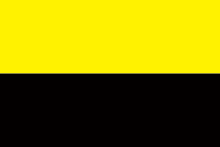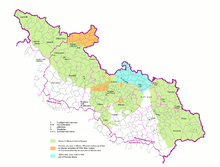- Czech Silesia
-
 Czech Silesia (green) and the so-called Moravian enclaves in Silesia (red) in relation to the current regions of the Czech Republic
Czech Silesia (green) and the so-called Moravian enclaves in Silesia (red) in relation to the current regions of the Czech Republic
Czech Silesia (Czech: České Slezsko; German: Tschechisch-Schlesien; Polish: Śląsk Czeski) is an unofficial name of one of the three Czech lands and a section of the Silesian historical region. It is located in the north-east of the Czech Republic, predominantly in the Moravian-Silesian Region, with a section in the northern Olomouc Region. Sometimes called Moravian Silesia (Czech: Moravské Slezsko), it is almost identical with the Duchy of Upper and Lower Silesia, also known as Austrian Silesia before 1918; between 1938 and 1945 the area was also named Sudeten Silesia, referring to the Sudetenland.
Contents
Geography
Czech Silesia borders Moravia in the south, Poland (Polish Silesia) in the north (in the northwest the County of Kladsko, until 1742/48 an integral part of Bohemia) and Slovakia in the southeast. With the city of Ostrava roughly in its geographic center, the area comprises much of the modern region of Moravian-Silesia (save for its southern edges) and, in its far west, a small part of the Olomouc Region around the city of Jeseník. After Ostrava, the most important cities are Opava and Český Těšín. Historically Český Těšín is the western part of the city of Cieszyn which nowadays lies in Poland.
Situated in the Sudetes, it is cornered by the Carpathians in the east. Its major rivers are the Oder (Polish, Czech: Odra), Opava and Olše (Polish: Olza) (which forms part of the natural border with Poland).
History
The first Germanic settlements were built in the second century. Later the Germanic tribes moved west and Slavs came into the country.[citation needed] Modern-day Czech Silesia derives primarily from a small part of Silesia that remained within the Bohemian Crown and the Habsburg Monarchy at the end of the First Silesian War in 1742, when the rest of Silesia was ceded to Prussia. It was re-organised as the Duchy of Upper and Lower Silesia, with its capital at Opava (German: Troppau, Polish: Opawa). In 1900, the Duchy occupied an area of 5,140 km² and had a population of 670,000.
In 1918, the former Duchy formed part of the newly-created state of Czechoslovakia, except the Cieszyn Silesia, which was split between Czechoslovakia and Poland in 1920, Czechoslovakia gaining its western portion. Hlučín Region (Czech: Hlučínsko, German: Hultschiner Ländchen), formerly part of Prussian Silesia, also became part of Czechoslovakia under the Treaty of Versailles in 1920.
Following the Munich Agreement of 1938, most of Czech Silesia became part of the Reichsgau Sudetenland and Poland occupied the Zaolzie area on the west bank of the Olza (the Polish gains being lost when Germany occupied Poland the following year).
With the exception of the areas around Cieszyn, Ostrava and Hlučín, Czech Silesia was predominantly settled by German-speaking populations up until 1945. Following the Second World War, Czech Silesia and Hlučínsko were returned to Czechoslovakia and the ethnic Germans were expelled. The border with Poland was once again set along the Olza (although not confirmed by treaty until 1958).
People
See also: List of people from SilesiaThe population mainly speaks Czech with altered vowels. Some of the native Slavic population speak Lach, which is classed by Ethnologue as a dialect of Czech,[1] although it also shows some similarities to Polish. In Cieszyn Silesia a unique dialect is also spoken, mostly by members of the Polish minority there.
Notable people from Czech Silesia include:
- Martin of Opava (Martinus Polonus) (†1278), chronicler, chaplain of several popes
- Heinrich Franz Boblig von Edelstadt (c. 1612–1698), egregious inquisitor
- Jiří Třanovský (1592–1637), pastor and hymnwriter, the "Luther of the Slavs"
- Gregor Mendel (1822–1884), biologist, founder of genetics (inheritance laws)
- Hans Kudlich (1823–1917), politician, main figure in the struggle for abolition of serfdom in Austrian Empire
- Paweł Stalmach (1824–1891), journalist and national revivalist
- Vincenc Prasek (1843–1912), historian
- Johann Palisa (1848–1925), astronomer
- Petr Bezruč (1867–1958), poet
- Josef Koždon (1873–1949), politician, leader of Silesian autonomists, proponent of the idea of a distinct Silesian nation ("Slonzaks")
- Helen Zelezny-Scholz (1882–1974), architectural sculptor
- Óndra Łysohorsky (1905–1989), poet, creator of the literary form of the Lach dialect
- Joy Adamson (Friederike Victoria Gessner) (1910–1980), writer
- František Vláčil (1924–1999), film director
- Armin Delong (1925–), scientist
- Věra Chytilová (1929–), film director
- Jaromír Nohavica (1953–), songwriter and poet
- Ivan Lendl (1960–), tennis player, 19 times finalist of Grand Slam tournaments
References
Notes
- This article incorporates information from the revision as of August 24, 2005 of the equivalent article on the German Wikipedia.
 Historical regions in the Czech RepublicCategories:
Historical regions in the Czech RepublicCategories:- Czech Silesia
- Geography of the Czech Republic
- Historical regions in the Czech Republic
- Geography of Silesia
Wikimedia Foundation. 2010.






